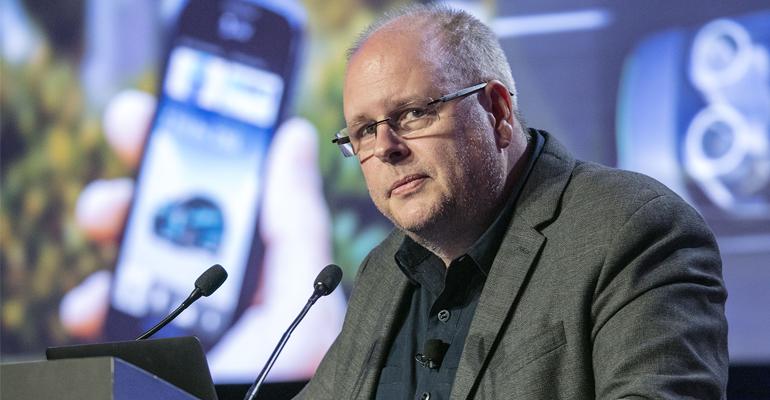TRAVERSE CITY, MI – The vast parking lot of the 14-story Grand Traverse Resort here is at near-full capacity. Drivers circle around looking for a rare empty spot. And off to the side, all four vehicle-battery rechargers go unused.
Meanwhile, inside the hotel, Danny Stillion tells an automotive conference audience about the coming age of mobility and self-driving vehicles. He foresees fewer cars plying roadways, making more parking spaces available. Or they will be replaced altogether with the likes of urban tomato patches or extra sidewalks to abate pedestrian traffic congestion.
In that new age, autonomous electric vehicles will rule. Internal combustion engines (under the hood of about 95% of today’s vehicles) will become virtually obsolete, says Stillion, a partner and executive design director at IDEO. “The I.C.E. age draws to a close.”
The emphasis of his job is on interactive design, something he says intersects with the company’s future transportation and mobility work with various automakers.
His keynote speech, “Preparing for a Bold New Future,” kicks off the Center for Automotive Research’s annual Management Briefing Seminars here.
The cited differences between the realities of today and visions of tomorrow are striking in many respects. It’s safe to say the owners of Grand Traverse Resort aren’t currently at work on re-purpose plans for all those parking spaces on the premise they won’t ultimately be needed.
After his speech, Stillion tries to reconcile those differences and put them in perspective, although “I’ve got out of the business of predicting when exactly these (new mobility) things will happen,” he tells WardsAuto. “We probably won’t see a sea change.”
But with an eye toward autonomous vehicles, the industry is showing rapid development in advanced-technology areas, such as connectivity, DSRC (dedicated short-range communication), LIDAR (3-D radar) and other semi-autonomous features.
“Three years ago, we thought some of the things we are seeing today would be years off,” Stillion says. “It seems like we see breakthroughs all the time.”
In his presentation, he shows future concept self-drivers that are boxy in exterior design (no gasoline engines, no hoods) but replete in interior functionality, including cones of silence for occupants. “I could have used one of those on the airplane ride here yesterday,” he says.
He asks his auto-industry audience to imagine a multipurpose vehicle for an assortment of people who would share it and experience it in their own ways. Moreover, the vehicle would sense their wants and needs.
“We’re excited about the possibilities that lie ahead,” Stillion says. “Charting the future begins with asking the right questions. Transformative technologies are required to move forward.”
Like others, he predicts fleet companies will own many of the self-driving cars of tomorrow. Sometimes, people will use those vehicle merely to get from A to B. Other times, they will use them as social settings on wheels, with features such as seats that face each other around a table – and more.
IDEO has worked with Hyundai on a concept vehicle interior that would include ambient lighting, acoustical prompts and special scents “all to affect (occupants’) moods,” Stillion says. “It’s exciting.”
If fleet companies own most of tomorrow’s vehicles as predicted, expect those to be on the move. Like ships that aren’t making money sitting in a port, shared vehicles won’t make money sitting around. “They need to be moving,” Stillion says.





